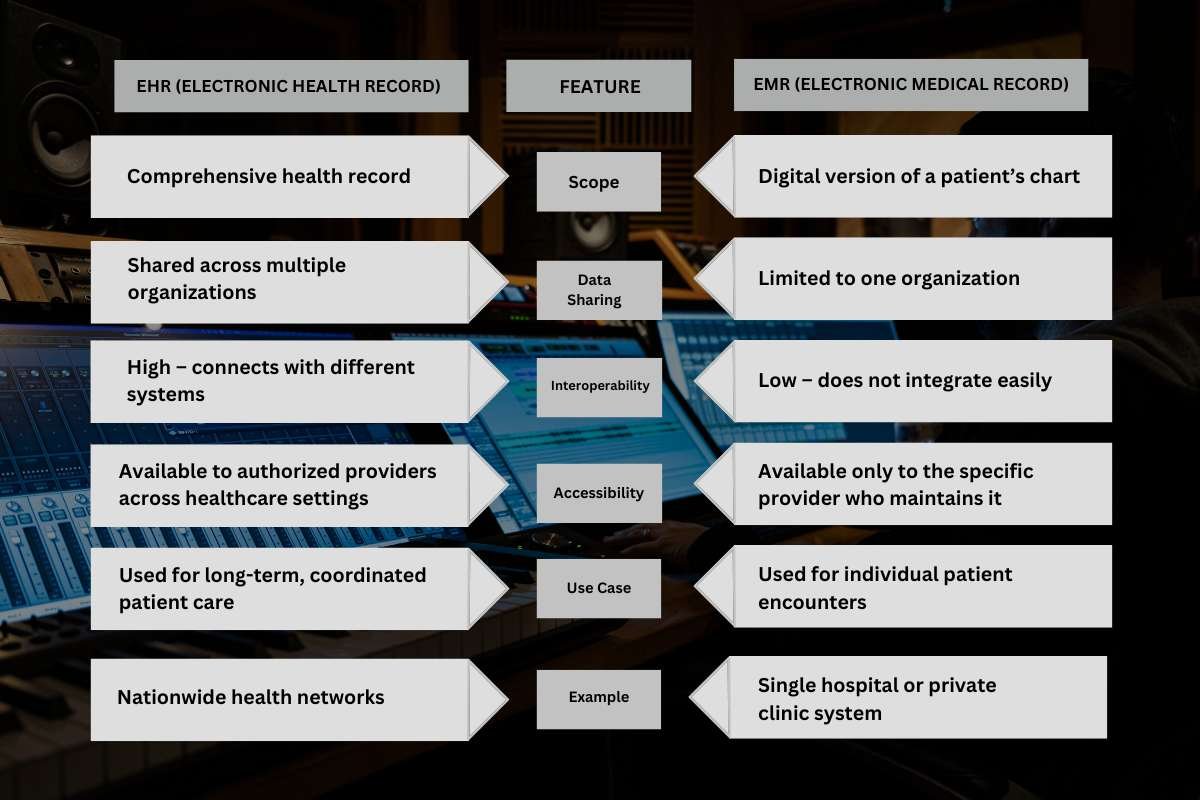With the rise in digitalization, electronic records are transforming the way patient data is stored, accessed, and managed by the staff. There are many ways and technologies to store confidential information about patients. However, everyone talks more about these two types of records: Electronic health records (EHR) and Electronic medical records (EMR). People often get confused and don’t understand the difference between EHR and EMR, assuming they are interchangeable.
However, both systems are equally important in the field of modern medicine. They are known for their unique functionalities, which impact patient care, data sharing, and interoperability.
In this article, we will explore the key difference between EHR and EMR along with their features, usage trends and how they are bring positive change in the healthcare industry.
What is an EHR?

An Electronic Health Record (EHR) is a digital system designed to provide a comprehensive, long-term view of a patient’s health. EHRs are maintained by multiple healthcare providers and can be shared across different organizations, enabling seamless access to a patient’s medical history, diagnoses, medications, treatment plans, and test results.
Key Features of EHRs:
- Interoperability: EHRs allow data sharing among hospitals, clinics, pharmacies, and labs.
- Comprehensive Records: They contain detailed health information, including previous illnesses, allergies, lab results, and imaging reports.
- Real-Time Updates: Authorized providers can access and update patient records in real time.
- Improved Patient Care: EHRs enable coordinated care by ensuring all providers have access to the same data.
Example: If a patient visits a primary care physician and later consults a specialist in a different city, the specialist can access the patient’s medical history through an EHR system.
What is an EMR?
An Electronic Medical Record (EMR) is a digital version of a patient’s chart within a single healthcare organization. EMRs are primarily used by individual healthcare facilities to track patient data, medical history, diagnoses, and treatments. Unlike EHRs, EMRs are not designed for seamless data sharing with external organizations.
Key Features of EMRs:
- Organization-Specific: EMRs are limited to a single hospital, clinic, or practice.
- Medical History Storage: They store patient history, prescriptions, and test results but do not facilitate data exchange.
- Efficient Record-Keeping: EMRs streamline documentation, reducing paperwork for healthcare providers.
- Limited Data Sharing: They do not easily integrate with other healthcare systems.
Example: A private clinic may use an EMR system to manage patient records, but if a patient seeks treatment at another facility, their records may not be readily accessible.
Difference between EHR and EMR
While both EHR and EMR systems store digital patient information, they serve different purposes. Here are the key differences between EHR and EMR:

| Feature | EHR (Electronic Health Record) | EMR (Electronic Medical Record) |
|---|---|---|
| Scope | Comprehensive health record | Digital version of a patient’s chart |
| Data Sharing | Shared across multiple organizations | Limited to one organization |
| Interoperability | High – connects with different systems | Low – does not integrate easily |
| Accessibility | Available to authorized providers across healthcare settings | Available only to the specific provider who maintains it |
| Use Case | Used for long-term, coordinated patient care | Used for individual patient encounters |
| Example | Nationwide health networks | Single hospital or private clinic system |
The primary difference between EHR and EMR is that EHRs facilitate seamless data exchange across different healthcare entities, while EMRs are designed for internal use within a single practice or hospital.
Learn More: 5 Hottest Trends in Health Informatics Industry
What Are the EHR vs. EMR Usage Trends?
The adoption of EHR and EMR systems has grown significantly in recent years due to advancements in healthcare technology and government regulations promoting digital health records. Here are some key EHR vs. EMR usage trends:
1. Increased Adoption of EHR Systems
Governments worldwide, especially in the U.S., have encouraged healthcare providers to transition from EMRs to EHRs. The Health Information Technology for Economic and Clinical Health (HITECH) Act has incentivized EHR adoption to improve patient care and data accessibility.
2. Shift towards Interoperability
As healthcare providers focus on patient-centred care, the demand for interoperable EHR systems has increased. Hospitals and clinics are integrating EHRs with telemedicine platforms, wearable devices, and AI-driven analytics to provide better treatment.
3. Cloud-Based EHRs Are on the Rise

Cloud-based EHR solutions are becoming more popular due to their scalability, cost-effectiveness, and ease of access. Unlike traditional on-premise EMRs, cloud-based EHRs allow providers to access patient data from any location.
4. Regulatory Compliance and Security Enhancements
With increasing concerns about data security and privacy, healthcare organizations are investing in advanced cybersecurity measures to protect EHR data. Compliance with HIPAA (Health Insurance Portability and Accountability Act) in the U.S. is essential for protecting patient information.
5. Artificial Intelligence (AI) and EHR Integration
AI-powered EHRs are enhancing predictive analytics, automating administrative tasks, and improving diagnostic accuracy. AI-driven tools are helping physicians make more informed decisions by analyzing large datasets in real time.
Learn More: Female vs Male Pelvis Bone: Key Differences and Importance in Anatomy
Conclusion
After understanding the key difference between EHR and EMR, it becomes convenient and simple for healthcare providers and administrators to keep track of records. It is also very crucial for both staff and patients. EMR is known for being digital charts for individual healthcare facilities, whereas EHR provides a complete, interoperable solution that improves patient care and coordination.
With the continuous advancement in healthcare technology, the EHR system is gaining preference over other choices because of its ability to share information around different providers. This leads to better patient care and streamlined healthcare processes. Due to the evolution in digital healthcare, implementing the EHR system will help in improving the efficiency, accessibility, and quality of patient care.
FAQ:
1. Is Epic considered an EMR or EHR?
Epic is primarily considered an Electronic Health Record (EHR) system rather than an Electronic Medical Record (EMR) system, due to its broader capabilities and focus on sharing patient information across multiple healthcare providers and organizations.
2. Can the abbreviations EHR and EMR be used interchangeably?
EHR and EMR are commonly used acronyms that are sometimes incorrectly used interchangeably. EHR stands for electronic health records, and EMR stands for electronic medical records.
3. What is the difference between EHR and his?
HIS is used by a wide range of healthcare professionals, such as doctors, nurses, and administrators. However, EHRs are primarily accessed by healthcare providers, who use the information to make clinical decisions.







